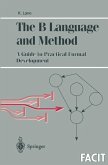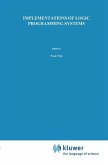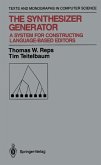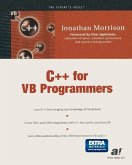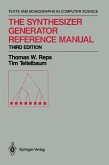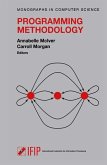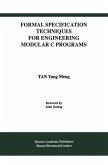ML with Concurrency (eBook, PDF)
Design, Analysis, Implementation, and Application
Redaktion: Nielson, Flemming
40,95 €
40,95 €
inkl. MwSt.
Sofort per Download lieferbar

20 °P sammeln
40,95 €
Als Download kaufen

40,95 €
inkl. MwSt.
Sofort per Download lieferbar

20 °P sammeln
Jetzt verschenken
Alle Infos zum eBook verschenken
40,95 €
inkl. MwSt.
Sofort per Download lieferbar
Alle Infos zum eBook verschenken

20 °P sammeln
ML with Concurrency (eBook, PDF)
Design, Analysis, Implementation, and Application
Redaktion: Nielson, Flemming
- Format: PDF
- Merkliste
- Auf die Merkliste
- Bewerten Bewerten
- Teilen
- Produkt teilen
- Produkterinnerung
- Produkterinnerung

Bitte loggen Sie sich zunächst in Ihr Kundenkonto ein oder registrieren Sie sich bei
bücher.de, um das eBook-Abo tolino select nutzen zu können.
Hier können Sie sich einloggen
Hier können Sie sich einloggen
Sie sind bereits eingeloggt. Klicken Sie auf 2. tolino select Abo, um fortzufahren.

Bitte loggen Sie sich zunächst in Ihr Kundenkonto ein oder registrieren Sie sich bei bücher.de, um das eBook-Abo tolino select nutzen zu können.
Both functional and concurrent programming are relatively new paradigms with great promise. In this book, a survey is provided of extensions to Standard ML, one of the most widely used functional languages, with new primitives for concurrent programming. Computer scientists and graduate students will find this a valuable guide to this topic.
- Geräte: PC
- ohne Kopierschutz
- eBook Hilfe
- Größe: 23.2MB
Andere Kunden interessierten sich auch für
![The B Language and Method (eBook, PDF) The B Language and Method (eBook, PDF)]() Kevin LanoThe B Language and Method (eBook, PDF)40,95 €
Kevin LanoThe B Language and Method (eBook, PDF)40,95 €![Implementations of Logic Programming Systems (eBook, PDF) Implementations of Logic Programming Systems (eBook, PDF)]() Implementations of Logic Programming Systems (eBook, PDF)72,95 €
Implementations of Logic Programming Systems (eBook, PDF)72,95 €![The Synthesizer Generator (eBook, PDF) The Synthesizer Generator (eBook, PDF)]() Thomas W. RepsThe Synthesizer Generator (eBook, PDF)40,95 €
Thomas W. RepsThe Synthesizer Generator (eBook, PDF)40,95 €![C++ for VB Programmers (eBook, PDF) C++ for VB Programmers (eBook, PDF)]() Jonathan MorrisonC++ for VB Programmers (eBook, PDF)43,95 €
Jonathan MorrisonC++ for VB Programmers (eBook, PDF)43,95 €![The Synthesizer Generator Reference Manual (eBook, PDF) The Synthesizer Generator Reference Manual (eBook, PDF)]() Thomas W. RepsThe Synthesizer Generator Reference Manual (eBook, PDF)72,95 €
Thomas W. RepsThe Synthesizer Generator Reference Manual (eBook, PDF)72,95 €![Programming Methodology (eBook, PDF) Programming Methodology (eBook, PDF)]() Programming Methodology (eBook, PDF)72,95 €
Programming Methodology (eBook, PDF)72,95 €![Formal Specification Techniques for Engineering Modular C Programs (eBook, PDF) Formal Specification Techniques for Engineering Modular C Programs (eBook, PDF)]() Tan Yang MengFormal Specification Techniques for Engineering Modular C Programs (eBook, PDF)112,95 €
Tan Yang MengFormal Specification Techniques for Engineering Modular C Programs (eBook, PDF)112,95 €-
-
-
Both functional and concurrent programming are relatively new paradigms with great promise. In this book, a survey is provided of extensions to Standard ML, one of the most widely used functional languages, with new primitives for concurrent programming. Computer scientists and graduate students will find this a valuable guide to this topic.
Dieser Download kann aus rechtlichen Gründen nur mit Rechnungsadresse in A, B, BG, CY, CZ, D, DK, EW, E, FIN, F, GR, HR, H, IRL, I, LT, L, LR, M, NL, PL, P, R, S, SLO, SK ausgeliefert werden.
Produktdetails
- Produktdetails
- Verlag: Springer US
- Seitenzahl: 255
- Erscheinungstermin: 6. Dezember 2012
- Englisch
- ISBN-13: 9781461222743
- Artikelnr.: 44175889
- Verlag: Springer US
- Seitenzahl: 255
- Erscheinungstermin: 6. Dezember 2012
- Englisch
- ISBN-13: 9781461222743
- Artikelnr.: 44175889
- Herstellerkennzeichnung Die Herstellerinformationen sind derzeit nicht verfügbar.
1 Introduction.- 2 The Essence of Concurrent ML.- 2.1 Introduction.- 2.2 The Fundamental Ideas.- 2.3 Overview of CML.- 2.4 The Semantics of Mini-CML.- 2.5 Events and Their Algebra.- 2.6 Expressiveness.- 2.7 Implementing Concurrency Abstractions in CML.- 2.8 Conclusions and Related Work.- 3 Concurrency in Poly/ML.- 3.1 Introduction.- 3.2 The Poly/ML Concurrency Primitives.- 3.3 The Uniprocessor Implementation.- 3.4 A Shared Memory Multiprocessor Implementation.- 3.5 The Development of a Distributed Implementation.- 3.5.1 Additional Primitives.- 3.6 Implementation on LEMMA.- 4 CCS Programming in an ML Framework: An Account of LCS.- 4.1 Introduction.- 4.2 Features of LCS.- 4.3 Typing Behavior Expressions.- 4.4 Operational Semantics.- 4.5 The Implementation Model.- 4.6 Conclusion.- 5 FACILE-From Toy to Tool.- 5.1 Introduction.- 5.2 Design and Development of FACILE.- 5.3 Language Features.- 5.4 Implementation.- 5.5 Applications.- 5.6 Conclusion.- 6 A Semantic Theory for ML Higher-Order Concurrency Primitives.- 6.1 Motivation and Background.- 6.2 Related Work.- 6.3 Informal Presentation.- 6.4 Static Semantics.- 6.5 Dynamic Semantics.- 6.6 Conclusion.- Appendix 6.A Semantic Functions.- Appendix 6.B Semantic Rules.- 7 Communication Analysis for Concurrent ML.- 7.1 Introduction.- 7.2 Extracting the Communication Topology.- 7.3 Semantics.- 7.4 Subject Reduction Property.- 7.5 Decidability Issues.- 7.6 Conclusion.- Appendix 7.A Syntactic Properties of the Typing System.- Appendix 7.B Semantic Properties of the Ordering.- Appendix 7.C Semantic Properties of the Typing System.- Appendix 7.D Decidability Issues Concerning the Orderings.- References.
1 Introduction.- 2 The Essence of Concurrent ML.- 2.1 Introduction.- 2.2 The Fundamental Ideas.- 2.3 Overview of CML.- 2.4 The Semantics of Mini-CML.- 2.5 Events and Their Algebra.- 2.6 Expressiveness.- 2.7 Implementing Concurrency Abstractions in CML.- 2.8 Conclusions and Related Work.- 3 Concurrency in Poly/ML.- 3.1 Introduction.- 3.2 The Poly/ML Concurrency Primitives.- 3.3 The Uniprocessor Implementation.- 3.4 A Shared Memory Multiprocessor Implementation.- 3.5 The Development of a Distributed Implementation.- 3.5.1 Additional Primitives.- 3.6 Implementation on LEMMA.- 4 CCS Programming in an ML Framework: An Account of LCS.- 4.1 Introduction.- 4.2 Features of LCS.- 4.3 Typing Behavior Expressions.- 4.4 Operational Semantics.- 4.5 The Implementation Model.- 4.6 Conclusion.- 5 FACILE-From Toy to Tool.- 5.1 Introduction.- 5.2 Design and Development of FACILE.- 5.3 Language Features.- 5.4 Implementation.- 5.5 Applications.- 5.6 Conclusion.- 6 A Semantic Theory for ML Higher-Order Concurrency Primitives.- 6.1 Motivation and Background.- 6.2 Related Work.- 6.3 Informal Presentation.- 6.4 Static Semantics.- 6.5 Dynamic Semantics.- 6.6 Conclusion.- Appendix 6.A Semantic Functions.- Appendix 6.B Semantic Rules.- 7 Communication Analysis for Concurrent ML.- 7.1 Introduction.- 7.2 Extracting the Communication Topology.- 7.3 Semantics.- 7.4 Subject Reduction Property.- 7.5 Decidability Issues.- 7.6 Conclusion.- Appendix 7.A Syntactic Properties of the Typing System.- Appendix 7.B Semantic Properties of the Ordering.- Appendix 7.C Semantic Properties of the Typing System.- Appendix 7.D Decidability Issues Concerning the Orderings.- References.

